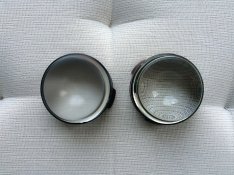Here I go again - back to Bob. Graphite goes all kinds of places you don't want it. And heaven help you if it gets inside a lens. I wouldn't use it anywhere near a camera or enlarger, not even a darkroom door lock. Typical anti-newton "offset" powder, as well as the primary ingredient in modern anti-newton sprays for scanning is a very finely sifted corn starch. You spray it into the air below a gentle fume hood, then swipe the negative through the mist. Never spray directly on the neg (speaking in general, Bob - I realize you probably know all this stuff better than I do). The old guys would just use a rubber puffer bulb instead, with dry corn starch powder. I keep some of the spray cans on hand, but haven't used them in a long time. Two problems. Unlike a correct AN glass, antinewton powder will inevitably show up on serious enlargements. And it still needs to be thoroughly cleaned off the neg afterwards. The aerosol version has some unhealthy things in the propellant. The primitive powder itself will attract booklice to your equipment, and tend attract them to things like bellows glue, or just become a nuisance like graphite. Offset presses were 1:1, not enlarging devices, so they didn't have quite the same concern.











